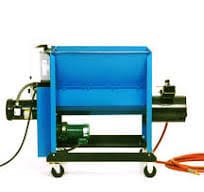Description
Air impinging devices encompass a group of seed cleaners that are useful for stripping the appendages from fluffy seeds using very high-speed air. These devices were developed and patented by Aaron Beisel, Fargo, Oklahoma, and Chet Dewald, USDA Agricultural Research Service, Woodward, Oklahoma.
First was the Woodward Laboratory Air-Seed Shucker that can be used to quickly determine purity at any phase in the seed cleaning process. The unit recycles seed material through a venturi until the impelling air blast and the acceleration force strips the appendages from the seed. The dense, clean seed drops from the recycling system. An air compressor powers the system, and sample size is about 10 grams. To obtain percentage seed, the seed mass extracted is divided by the total mass of the material sampled and multiplied by 100. The device is useful for rapidly cleaning small lots for seed testing (germination, viability). It can also be used to aid in selecting appropriate screen sizes for cleaning larger lots, monitoring the progress of cleaning operations, and indicating the presence of weed seeds that may require adjustments of the cleaning process. This device found use for cleaning fluffy grass seed in North America, New Zealand, and Australia, but is not currently available commercially.
Second was the Woodward Chaffy Seed Conditioning System. Unprocessed seed is metered from a variable-speed, rotating basket onto a high-intensity, oscillating scalper to remove stems, leaves, and light debris. Rotation of the wire basket loosens the entangled unprocessed seed, provides rough cleaning, and controls the flow of material to the scalper and the aerodynamic conditioning system. Following scalping, the aerodynamic conditioning system uses an air blast and the resulting acceleration force caused by a venturi to detach a selected portion of the appendages from the seed. The amount of detachment can be controlled by adjusting the air blast and acceleration force. A cross-air-flow device removes trash and sends the air-entrained seed to a momentum discriminator that separates seed according to density. The system has effectively processed seed of bluestem species (Bothriochloa spp.) and other species with chaffy seed.
Third was the Woodward Chaffy Seed Conditioner 2000. This unit was developed to clean Texas bluegrass (Poa arachnifera Torr.) seed, which are extremely fuzzy seed that clings together to form cotton-like rolls or balls. The conditioner 2000 is a single unit with three phases: uniform metering, preconditioning, and quality classification of chaffy seeds. Two variable-speed, horizontal feed augers supply seed to a variable-speed, seed-delivery auger. The rubbing action between the seed masses and the augers separates the seed masses into smaller portions that are then fed into a preconditioning chamber. In the chamber, rotating paddles force seed through a scalping screen. Compressed air aids movement of the seed to the classification unit and assists in expelling debris from the chamber. The classifier sends the air-entrained seed through a venturi for further cleaning. A change in the direction of the air stream carries extraneous material from the system and classifies the seed by propelling the heavier seed further in the momentum discrimination collector.
References / Additional Information
Air-Seed Shucker
USDA Forest Service. 1991. Rangeland Technology Equipment Council. 1990 Annual Report. 9122-2805-MTDC. Missoula, MT: USDA Forest Service Technology & Development Center. 83 p.
USDA, USDI. 1983. 37th Annual Report of the Vegetative Rehabilitation & Equipment Workshop (VREW); 1983 February 13 & 14; Albuquerque, NM. Missoula, MT: USDA Forest Service Equipment Development Center. 69 p.
USDA, USDI. 1984. 38th Annual Report of the Vegetative Rehabilitation & Equipment Workshop (VREW); 1984 February 14 & 15; Rapid City, SD. Missoula, MT: USDA Forest Service Equipment Development Center. 63 p.
USDA, USDI. 1988. 42nd Annual Report of the Vegetative Rehabilitation & Equipment Workshop (VREW); 1988 February 21 & 22; Corpus Christi, TX. Forest Service Technology & Development Program. 49 p.
USDA, USDI. 1990. 43rd Annual Report of the Vegetative Rehabilitation & Equipment Workshop (VREW); 1989 February 19 & 20; Billings, MT. Missoula, MT: USDA Forest Service Technology & Development Center. 17 p.
Woodward Chaffy Seed Conditioning System
Dewald, C.L.; Beisel, V.A.; Sims, P.L. 1987. Concepts and principles of the Woodward chaffy seed conditioning system. In: Frasier, G.W.; Evans, R.A., eds. Seed and seedbed ecology of rangeland plants. Washington, DC: U.S. Department of Agriculture: 278-282.
Dewald, C.L.; Springer, T.L.; Beisel, V.A. 2003. The Woodward chaffy seed conditioner 2000. Applied Engineering in Agriculture. 19(2): 219-223.
USDA, USDI. 1988. 42nd Annual Report of the Vegetative Rehabilitation & Equipment Workshop (VREW); 1988 February 21 & 22; Corpus Christi, TX. Forest Service Technology & Development Program. 49 p.
Woodward Chaffy Seed Conditioner 2000
USDA, USDI. 1988. 42nd Annual Report of the Vegetative Rehabilitation & Equipment Workshop (VREW); 1988 February 21 & 22; Corpus Christi, TX. Forest Service Technology & Development Program. 49 p.
USDA, USDI. 1990. 43rd Annual Report of the Vegetative Rehabilitation & Equipment Workshop (VREW); 1989 February 19 & 20; Billings, MT. Missoula, MT: USDA Forest Service Technology & Development Center. 17 p.


